Spring has sprung here in the Southern Hemisphere. In most bird homes, this means an influx of hormones and seasonal behaviours but surprisingly that’s not a problem I seem to be having this season with my own pet flock. Instead, spring seems to be making itself felt in the wildlife rescue part of my life. Gale force winds and bird’s nests don’t tend to get along! We’ve had our share of them with the change in season.
Last year, I wrote a post about a nesting pair of wild Australian ravens and what they could teach us about training birds. (Click here to read that.) I was fascinated by the way they constructed lessons for their offspring and couldn’t quite believe my luck in getting to witness them.
Their nest survived many sets of gale force winds, allowing them to successfully raise several clutches of offspring. In the winter months, a fat male Brushtail Possum took possession of the nest converting it into a possum drey. During the day you’d see his tail hanging over the edge, gently swaying in the breeze. That ended abruptly about a month ago.
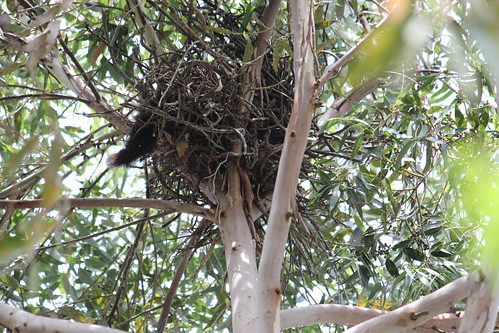
You can see the end of the male Brushtail Possum’s tail hanging out of the lefthand side of the nest.
There’s no mistaking the sound of a fat male Brushtail coming home to its drey early one morning (pre-sunrise) to find 2 angry adult ravens have returned and repossessed their nest. The fights lasted for a couple of nights and you can probably guess who won? There’s no mistaking the sound of an overweight male Brushtail possum making a calculated retreat into your roof cavity, directly above the bed you’re trying to sleep in. (I’m allowed to make cracks about his weight because I’m the one that had to carry his heavy butt out of the roof cavity to his new possum box, after I fixed the broken roof tiles.)
So with a serious case of déjà vu I’ve been watching the raven lessons start up again. Awesome, right?
Well this brings me to the wildlife rescue side of things. About a week after some particularly strong winds, I was contacted about a baby raven that couldn’t fly. The woman who had found it, had rung a wildlife organization and was told to put it somewhere where its parents could find it but dogs and cats couldn’t. No parents showed up and so the raven wound up in her spare rabbit hutch at night, being released during the day. I was tagged in a post on Facebook, asking if I could help? Despite the worldwide nature of Facebook the bird wasn’t far from me, so I could.
I went and assessed it. It really couldn’t fly (could only glide a little) and that worried me because at its age it should have been well and truly flying. I quickly checked it and found cuts under both wings, which might have stopped it from learning to fly, but shouldn’t be a permanent problem. It had mites and other signs of injury too, so I took it to my avian vet. It had a wound on its chest, another on its head, as well as multiple cuts under both wings. It also had scar tissue on one foot from an even older injury. It was underweight, with a body condition of maybe 1-2. Needless to say it required treatment for the above.
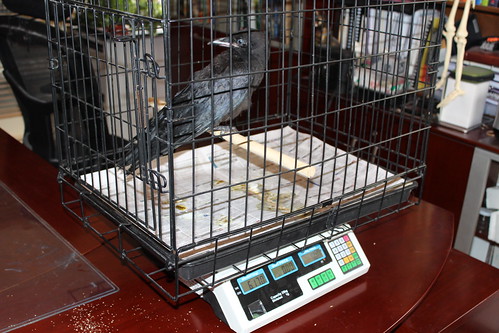
How to weigh a wild bird? Have the weight of your travel carrier recorded somewhere, so you can subtract it from the weight that includes the bird.
I don’t normally bring wildlife cases home unless there is some sort of mitigating circumstance. I’m a rescuer/transporter not a shelter. I have pets – and I’m not just talking about birds. It isn’t a great idea to mix domestic and wild together. You don’t want a wild animal watching dogs and cats interacting in a friendly way and learning to be less frightened of them as a result. Nor do I want to accidentally expose my pets to a disease a wild animal is carrying. This is why I choose to help wildlife through rescue/transport instead of as a foster carer. However, I am licensed and linked to shelter operators, so in an emergency (like when a shelter is overrun during bushfires) I will do foster care work and have fencing and enclosures on hand that I can put up as needed.
It struck me that I might have found a different sort of mitigating circumstance. This baby raven was orphaned and injured. Possibly thrown from a nest in that last windstorm? Maybe it had been blown too far away for the parents to find it? Then it seems to have been attacked by a cat? But its injuries were surprisingly minor and weren’t the cause of it not thriving.
No, its main problem seemed to be lack of knowledge. It didn’t know how to ascend/descend or land. It had basic instincts allowing it to take off and glide but there was no control there. It also didn’t seem to know where to find food (or want to) and how to avoid cats. It had learned the terrible lesson that humans equal minced meat, making it way too tame for a wild bird. It was basically a few weeks behind where it should be in life skills with a few bad habits thrown in for fun. It struck me that it needed the raven lessons that I knew were going on at my home.
Which left me with the question – would the ravens at home teach a baby that wasn’t their own how not to die? Well, why not? I knew from last year that their second and subsequent clutches of babies was placed to observe them teaching the previous clutch how to fly, etc. What if I set up an aviary where the baby raven could observe these lessons too? Even if my ravens had no interest in this raven, it would still be positioned to see them and maybe I could mimic the lessons myself while simultaneously dealing with its injuries and body condition? It was a plan.

With daylight fading, a smaller enclosure would allow the raven chick to familiarize itself with its environment for the night quickly.
By the time we got home from the vet’s on that first day, there was approximately an hour’s daylight left. So I decided night one would be spent in a crate, looking out at the spot where I would assemble the aviary the next day. I carefully selected a branch and foliage from a tree I knew my local ravens use during bad weather. It’s a safe, stable tree that provides great shelter. Familiarity with its foliage couldn’t hurt.
The first step was clearly to teach this bird that food bowls aren’t where food comes from and that food moves. I prepared a “foraging tray” that included samples of what this raven needed to learn to look at for food. So we’re talking different types of grass (roots, mud and all) that conveniently still had worms in them. Millipedes, beetles, woodlice/slaters – it turns out that my kitten’s love of hunting insects is handy. I followed her for 10 minutes and had a good collection of “creepies” (mum’s word not mine) to shove in this tray. Oh and that wailing sound? That’s my mother still screaming at me. She got just a little bit upset that I’m now keeping live insects in the fridge next to the milk. (It’s not my fault that mealworms go in to a state of torpor and therefore last longer in the fridge!!!)
Apart from the lovely “creepies” I was also mixing up a supplement called “insectivore” which is commonly used to raise this sort of bird. It smells bad and looks like mud but it does the job.
The next day I moved the chick out into the aviary in view of the adult ravens who were busily raising their own young. I added numerous foraging trays to the bottom of the aviary. Some were small stones, some were leaves and twigs, some were grass based. All common things this raven needed to learn to search through.
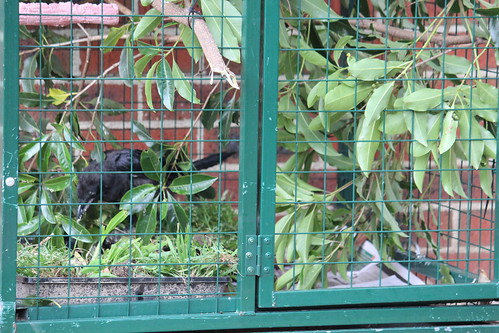
Hunting in the foraging trays. Overloaded with food to make it easy, but the raven seems to be getting the idea.
The adult ravens kept a close eye on what was going on, but generally left the chick alone. They proceeded to collect food and feed it to their own young. They didn’t feed the chick no matter how much it cried, but they were calling back and forth.
The male worried me because it came over and seemed to try to peck at the chick through the roof of the aviary, but it didn’t try that again. He seemed to increase his bug hunting which gave me hope for a while that he was going to feed the orphan, but he didn’t. (I’m 100% sure of this as I have surveillance cameras and checked the footage.)
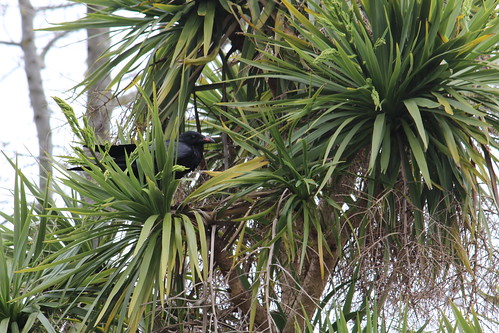
The adult male raven has approached the baby several times and seems to have stepped up the food hunt – hunting bugs here.
The main challenge turned out to be getting the chick to descend to forage. It was quite happy (if a little clumsy) in its attempts to get to the highest perch but once there, it refused to jump down more than one or two branches. It was as though it reached some sort of fear threshold and would just freeze. I carefully arranged the branches to be similar to a tree, but easy enough to jump from one to another. I didn’t want to handle the bird much (better if it has a healthy fear of humans) but occasionally put it down the bottom of the aviary to forage and work its way up its “tree” in the vague hope that if it learned how to go up confidently, following the reverse path might become less frightening. This had limited success. The chick agreed to go down one more perch but no further.
Well the answer to this was to start some flight training. The aviary it was in, is on wheels and so easy enough to move into my outdoor patio. Fishing nets formed walls, turning it into a temporary flight. I set it up similar to how the wild ravens do. They start their babies off with horizontal flights from a tree to a rooftop. I was placing mealworms on my outdoor table (so no more than a metre drop from the aviary’s top perch). From this he’d fly to the ground. When done with training exercises, I’d move the aviary back to in view of the wild ravens lessons. They were small steps, but enough to build the bird’s confidence so he started ascending and descending within the aviary on his own.
The other thing that happened was the raven had a bath, washing off the last of the dried blood under its wings. It also preened out some broken feathers. The next day, it had a weight drop and I wasn’t sure if there was an underlying disease or if it was due to the dried blood and feathers being removed? I’d know in 24 hrs. The bird desperately needed to put on weight, so I found myself looking to the wild ravens for an idea.
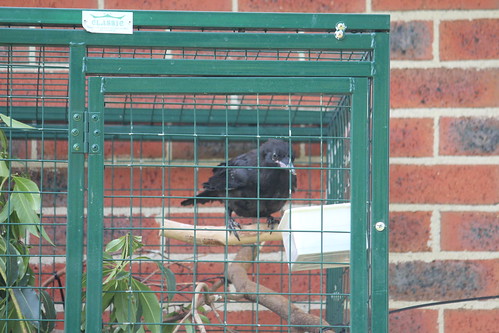
Imitating the way the parent ravens hide food in gutters, I filled a food bowl with mud and leaves, with food inside it. “Insectivore” (a rearing food) looks like mud, so that’s in there too.
It seems wild ravens like to fill people’s guttering with mud, hide worms and other creepies in them and get their babies to hunt them out… Well I didn’t have any spare guttering lying around but I did have a long plastic hook-on food bowl, mud and plenty of creepies. Combine that with a bird that wants to be up high – it couldn’t hurt. Fortunately the additional food seemed to help. Within 24 hrs its weight had significantly risen.
Naturally, there had to be another hiccup in my plans. Namely gale force winds. With a severe weather warning in place for my area, I wasn’t comfortable in leaving a solitary baby bird outside in an aviary overnight. I decided to bring it in to the crate to sleep out the storm. As daylight faded, I reached in and grabbed the baby. By now it had a healthy fear of humans. (I hadn’t handled it more than necessary.) It started screaming a distress call. The next thing I knew the wild parent ravens were on me. Both of them were swooping me, using their beaks as large stabbing sticks on each swoop. I had no choice but to put the baby back down in the aviary and make a run for it. If they were protecting the baby, I wasn’t willing to break that new-formed bond.
I came back after dark and took the baby to safety then. Carefully holding its beak closed to stop the distress call so the parents didn’t hear me. This meant it safely rode out the storm in the crate inside. Meanwhile I woke up to some seriously mad wild ravens screaming their heads off just outside my bedroom window at dawn. I quickly weighed the baby and got it back out there.
I had a decision to make. The baby’s weight had continued to rise, but it was still 5g below what I had set as a releasable goal. The weather forecast for the day was great, low wind, not too hot, not too cold. Rain and wind predicted for the next day – which wouldn’t be ideal for a new release to learn to fly in, but wonderful for a recent release that is looking for water. More importantly, it was fast reaching an age when parents would be less likely to look after it. I had parents acting like they wanted to adopt it. If there was any chance they would and that delaying release to wait for more weight could stop them… I knew this baby stood a better chance of survival if it had a community of its own kind behind it. The decision seemed obvious.
I fed it, gave it a chance to eat and digest the food, opened the door and waited. For 10 minutes it continued to move around the aviary, looking at the open door. Then the adult male flew overhead, landed behind me and emitted one loud CAW.
The baby flew out and landed within a few metres of me. The adult male swooped down and quickly fed it. A technique I’d seen it use on its own offspring, when rewarding flight.
In that split second, I knew it was going to be ok. I also knew that I had to get out of the way before the adult decided I had to die again. He obviously wasn’t keen on me at the moment and if ever there was a death stare…
He called the baby up to the fence with him, but the baby wasn’t so great at flying yet and wound up flying to a nearby roof.
From there, he coaxed it to fly to a nearby eucalyptus tree (in view of the nest where the adult female was guarding the nest bound chicks), fed it and left it while he disappeared in search of food.
The chick stayed put for well over an hour and the adult female kept emerging from the nest to check it.
Then suddenly the baby flew off and landed in a neighbour’s hedge. I could hear a small dog going absolutely nuts and looked around for the parent ravens. They were nowhere near. The chick had traveled over 500metres and it occurred to me that they hadn’t been watching it to know it had done that.
I walked down the street to check it out. I found the baby stuck on a shed roof, with two yipping dogs below it. It clearly didn’t know where to go or what to do. I got a net and got up on the roof. (Met a neighbour I’d never seen before, “Why are you on my roof?” is a real icebreaker.) I got within a metre of the baby when the adult male appeared and wow was he displeased to see me! I’m pretty sure that was a very rude word in raven. He took the baby off with him to a safe tree. I realized then, that the adoption really had happened. It wasn’t my imagination. These ravens were going to fight to the death for this chick.
A few hours later, they were back in my neighbour’s garden, where the ravens like to collect worms. The chick was on the ground foraging. The male was on the roof above, ready to swoop.
It seemed the male raven was in full lesson mode, taking the chick from one location to another. The chick wasn’t just watching the ravens search for food either. A local blackbird, kept dropping in and snatching worms and flying off too.
I knew that around 5pm every night, all of the local ravens tend to meet up and fly around the neighbourhood together for at least 10minutes. I was waiting with bated breath in hopes of seeing something like this:
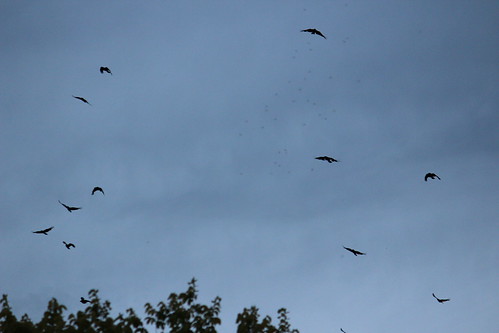
My local flock of ravens flies up to join those distant specks almost every night (every raven in the entire area joins up for about 10mins).
However, it got really windy, so instead I found the adult male, chick and the last clutch of juveniles some distance away in a tree. They were only small specks in the tallest tree but you could pick the baby apart from the others due to its inability to land properly (kept falling off tree branches and clumsily landing on another). The adult male also kept zipping back to the nest from that tree. (Apparently ravens can spot pesky attacking miner birds from some distance.)
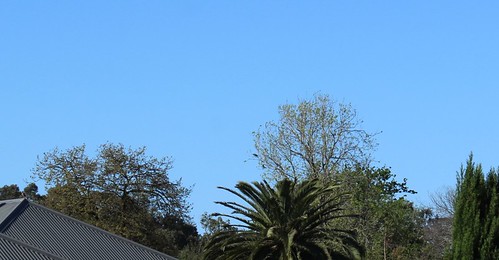
Not easy to see. You’re looking at approximately 5 black specks in the tallest tree. 3 of them are on the left hand branches.
As night quickly fell I could hear the anxiety in the adult male’s calls as he tried to extricate the chick from that tree. Eventually he managed it though. The female climbed into the nest (presumably to keep younger chicks warm) and the adult male and adopted chick, settled within a metre of the nest.
Having come to know these birds unbelievably well in the last few years, I think I can safely say that the baby is going to make it to an adult now that it has help from its own kind. When a rescue goes this well – it’s a dream scenario. If the raven hadn’t met a human with a spare rabbit hutch, I don’t think it would have made it. It takes one moment of compassion to start a chain of events that can make a real difference to an animal’s life.
I was expecting to end this post here, but I know that some of the locals who have been following this story on Facebook are going to be worried after yesterday. The bit of wind and showers that were predicted? We got hit by a really full-on storm. Trees are down. Power has been out. My yard isn’t pretty. Huge ceramic pots that I can’t even lift have been picked up by the wind and hurled at the house. I was out on a different rescue during the storm, avoiding flying sofas with my car. I came home and checked on the ravens and there weren’t any around to check. I’m not just referring to the orphan and adoptive parents – I’m saying the local flock of 40 was gone. It wasn’t just the ravens either. The blackbird was missing, the local dove flock was gone, no sign of my resident king parrots, corollas, or galahs either. It was eerily silent. They came back the morning after the storm. I believe the chick is still with the other young ravens as there are still “feed me” calls coming from their eucalyptus tree a few streets away and the adult male visits the nest and then heads back there.
There was one exception. I kept an eye out and saw the adult male silently flying in as darkness fell. He was checking the nest which had survived the storm. The female was still in it with the nest bound chicks. From the sounds – he fed her and left. He flew off into the distance, further than I could see and he didn’t come back again that night. None of them did. Wherever the orphan chick was, I was confident that the adult male was spending the night with it and likely the rest of the local ravens too. He wouldn’t stay away from his own nest for any other reason. It seems the wild birds knew this area was going to be hit badly and had flown to a safer place to ride out the storm, but it was already getting dark when the storm ended so they stayed away for the night.
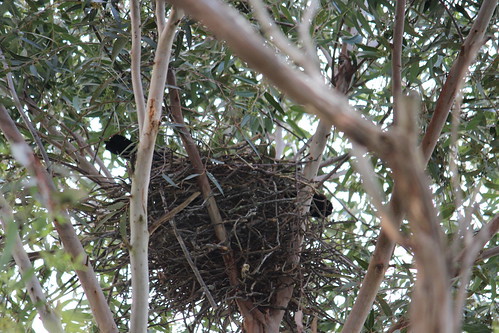
The morning after the storm. The female’s tail is visible on the left, the male’s on the right and the babies are noisy. The male flew off from here to where I could hear an older baby bird calling.
I’ve spent a lot time in university lectures listening to biologists tell me that an animal’s sole purpose/aim in life is to reproduce and pass on its own genetic material. Then in the real world, I meet a pair of ravens who willingly share their own babies’ food with an orphan. They’re even willing to leave their own young in order to protect the orphan. I can’t help but think we as humans underestimate the other animals around us.
If you find a baby bird and want to help it, click here for a post that will help you with that.
Mel Vincent lives in Melbourne, Australia and is a wildlife rescuer, vet student and animal trainer.



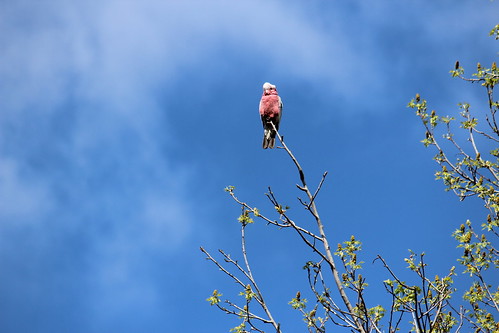
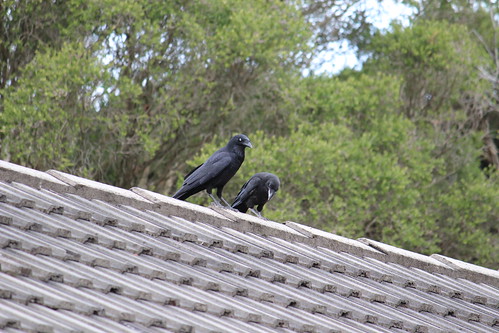

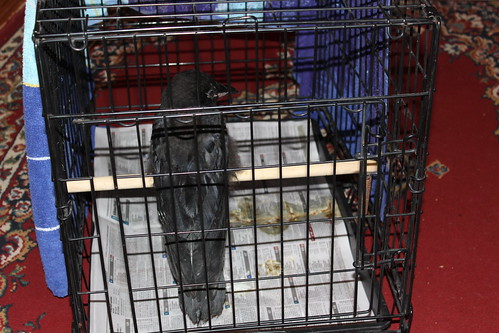

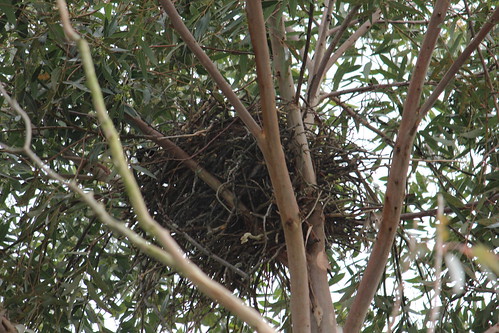

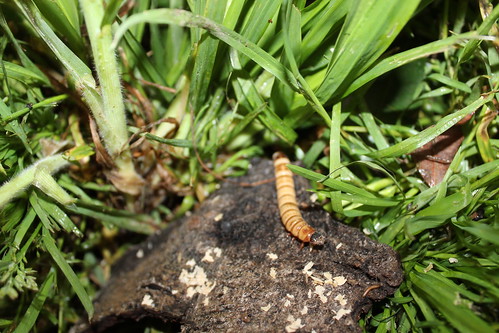

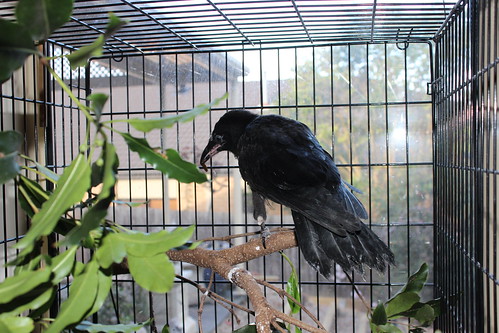
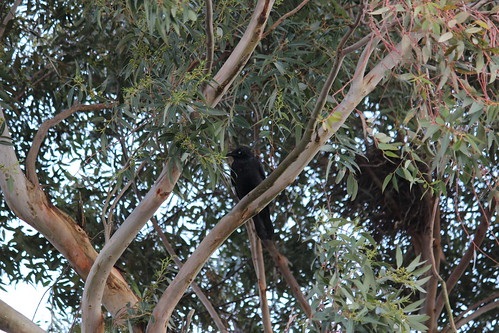
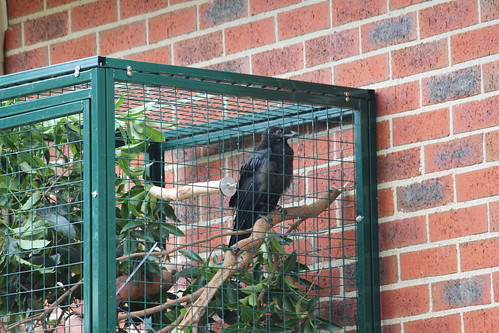

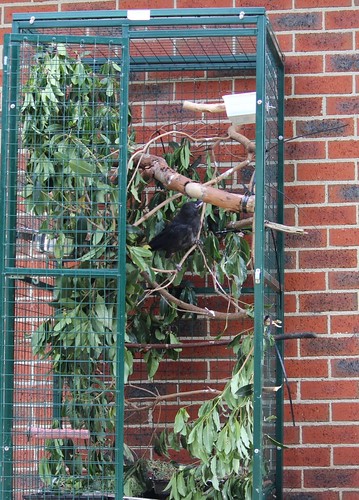


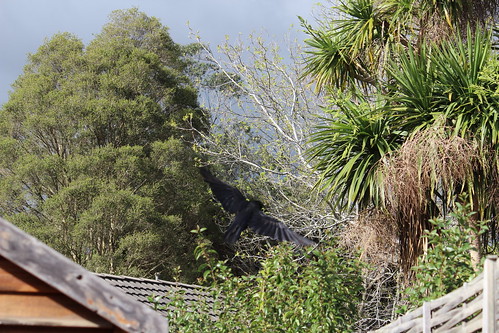
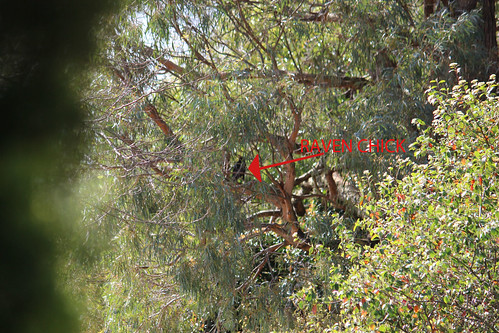


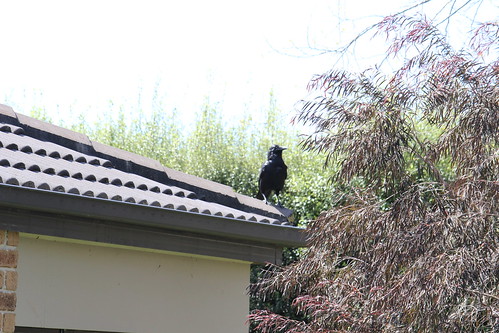

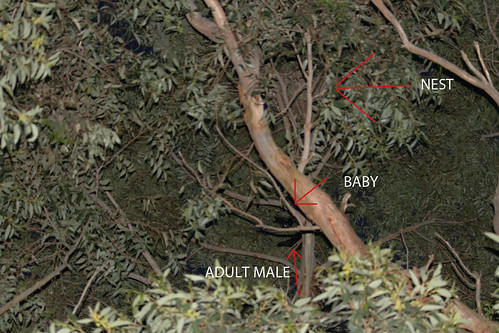
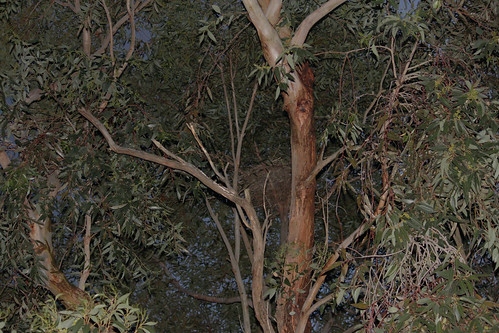
1 comment
So pleased we were able rescue and give this little baby a second chance :)
Leave a comment